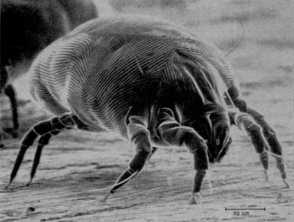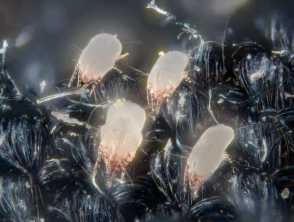What is a house dust mite?
A house dust mite is an eight-legged arachnid with a three-month life cycle of egg, larva, protonymph, tritonymph, and adult stages. The adult mite is transparent and 0.25-0.33 mm in length. The female lays 50–80 eggs during her lifetime. Each immature mite stage sheds a hard exoskeleton of chitin which is an aeroallergen, although the main allergens derive from the membrane encasing faecal pellets. The house dust mite feeds on skin scales, so increased numbers are found in association with humans with dermatoses that cause increased skin shedding.
The most common house dust mite species in temperate zones are Dermatophagoides pteronyssinus (Der p), Dermatophagoides farina (Der f) and Euroglyphus maynei (Eur m). Blomia tropicalis (Blo t) is also found in tropical climates. House dust mites are not found in the Arctic or Antarctic due to the cold temperatures, or at high altitudes where there is low humidity - the mite requires a humidity level above 75%. House dust mites avoid light so appear on exposed surfaces only at night. The highest mite numbers are found in carpeted bedrooms and living rooms, in couches and beds, especially sheepskin bedding and clothing.
House dust mite
Who is affected by house dust mites?
House dust mites produce aeroallergens that can cause hypersensitivity particularly in atopic individuals — those with atopic dermatitis, allergic rhinitis, and allergic asthma.
House dust mites produce the most relevant airborne allergens for atopic dermatitis.
Particles containing mite allergens are undetectable in the air of undisturbed rooms, however will become airborne after disturbing contaminated surfaces such as making a bed or vacuuming carpet. Contact can also be more direct such as via pillows, soft toys, or clothing.
What causes house dust mite hypersensitivity?
House dust mite allergens may be inhaled, ingested, or contacted directly to the skin or eye.
There are many potential allergens related to house dust mites, the most sensitising of which are Der p1/Der f1 (cysteine proteases) and Der p2/Der f2 (lipid-binding auto-adjuvants). Der p11 (paramyosin homologue) is a major allergen in atopic dermatitis. Polysensitisation is common in atopic dermatitis.
Dust mite particles contain proteases (proteolytic enzymes) and pathogen-associated molecular patterns (PAMPS).
In atopic dermatitis, proteases:
- Activate PAR-2 (protease-activated-receptor-2) in epidermal keratinocytes and dermal nerves leading to non-histamine-mediated itch and delayed skin barrier healing
- Promote cytokine-mediated inflammation
- Disrupt the skin barrier function allowing interaction with local immune cells to initiate types I (immediate) and IV (delayed) hypersensitivity reactions. [see Allergies explained]
What are the clinical features of house dust mite?
House dust mite aeroallergens may cause exacerbation of atopic dermatitis on exposed sites such as the face and arms. There may be particular aggravation in the morning on skin that directly contacts bedsheets overnight. There may be a seasonal association with flares in Spring and Summer months.
House dust mite hypersensitivity also exacerbates allergic rhinitis, allergic conjunctivitis, and allergic asthma.
What are the complications of house dust mite hypersensitivity?
- Secondary bacterial infection of the skin following scratching
- Atopic dermatitis resistant to treatment
- Cross reaction with chitin in crustaceans and cockroaches (Der p10)
- Impact on quality of life for the patient and their family
How is house dust mite hypersensitivity diagnosed?
House dust mite hypersensitivity should be considered clinically in atopic dermatitis refractory to treatment.
Investigations may include:
- Atopy patch test
- Skin prick testing
- Serum immunoglobulin E testing (RAST, ELISA).
What is the differential diagnosis for house dust mite hypersensitivity?
- Contact dermatitis
- Colonisation with Staphylococcus aureus, Candida spp, or dermatophytes
- Other airborne hypersensitivity reactions
What is the treatment for house dust mite hypersensitivity?
- House dust mite eradication measures
- Allergen-impermeable mattress and pillow covers
- Carpet removal or frequent vacuuming
- Washing clothes and bedlinen in hot water (>60C)
- Dehumidification
- Immunotherapy
- Sublingual, subcutaneous, oral, and dermal routes
- Allergen specific or crude house dust mite extracts
The effectiveness of eradication and desensitisation interventions remains uncertain and should only be considered in patients with atopic dermatitis and proven house dust mite hypersensitivity.
What is the outcome for house dust mite hypersensitivity?
Guidelines for the management of house dust mite hypersensitivity in atopic dermatitis remain unclear and inconsistent due to low-quality clinical trials.

